NFL theme by Nightfall24
Download: NFL_2.p3t
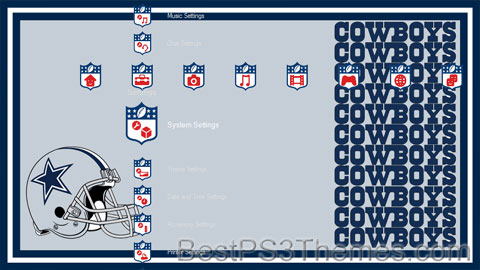
(1 background)
Redirect to:
This page is a redirect. The following categories are used to track and monitor this redirect:
|

The #1 spot for Playstation themes!
NFL theme by Nightfall24
Download: NFL_2.p3t

(1 background)
Redirect to:
This page is a redirect. The following categories are used to track and monitor this redirect:
|
GTA San Andreas (SD) theme by Jinx
Download: GTASASD.p3t
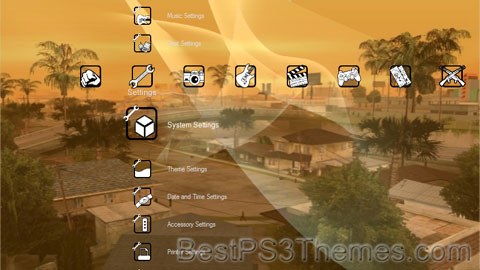
(3 backgrounds)
P3T Unpacker v0.12
Copyright (c) 2007. Anoop Menon
This program unpacks Playstation 3 Theme files (.p3t) so that you can touch-up an existing theme to your likings or use a certain wallpaper from it (as many themes have multiple). But remember, if you use content from another theme and release it, be sure to give credit!
Download for Windows: p3textractor.zip
Instructions:
Download p3textractor.zip from above. Extract the files to a folder with a program such as WinZip or WinRAR. Now there are multiple ways to extract the theme.
The first way is to simply open the p3t file with p3textractor.exe. If you don’t know how to do this, right click the p3t file and select Open With. Alternatively, open the p3t file and it will ask you to select a program to open with. Click Browse and find p3textractor.exe from where you previously extracted it to. It will open CMD and extract the theme to extracted.[filename]. After that, all you need to do for any future p3t files is open them and it will extract.
The second way is very simple. Just drag the p3t file to p3textractor.exe. It will open CMD and extract the theme to extracted.[filename].
For the third way, first put the p3t file you want to extract into the same folder as p3textractor.exe. Open CMD and browse to the folder with p3extractor.exe. Enter the following:
p3textractor filename.p3t [destination path]Replace filename with the name of the p3t file, and replace [destination path] with the name of the folder you want the files to be extracted to. A destination path is not required. By default it will extract to extracted.filename.
GTA San Andreas theme by Jinx
Download: GTASAHD.p3t
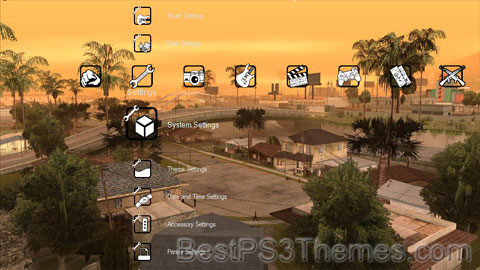
(3 backgrounds)
P3T Unpacker v0.12
Copyright (c) 2007. Anoop Menon
This program unpacks Playstation 3 Theme files (.p3t) so that you can touch-up an existing theme to your likings or use a certain wallpaper from it (as many themes have multiple). But remember, if you use content from another theme and release it, be sure to give credit!
Download for Windows: p3textractor.zip
Instructions:
Download p3textractor.zip from above. Extract the files to a folder with a program such as WinZip or WinRAR. Now there are multiple ways to extract the theme.
The first way is to simply open the p3t file with p3textractor.exe. If you don’t know how to do this, right click the p3t file and select Open With. Alternatively, open the p3t file and it will ask you to select a program to open with. Click Browse and find p3textractor.exe from where you previously extracted it to. It will open CMD and extract the theme to extracted.[filename]. After that, all you need to do for any future p3t files is open them and it will extract.
The second way is very simple. Just drag the p3t file to p3textractor.exe. It will open CMD and extract the theme to extracted.[filename].
For the third way, first put the p3t file you want to extract into the same folder as p3textractor.exe. Open CMD and browse to the folder with p3extractor.exe. Enter the following:
p3textractor filename.p3t [destination path]Replace filename with the name of the p3t file, and replace [destination path] with the name of the folder you want the files to be extracted to. A destination path is not required. By default it will extract to extracted.filename.
Chalk XMB theme by georgatos
Download: ChalkXMB.p3t
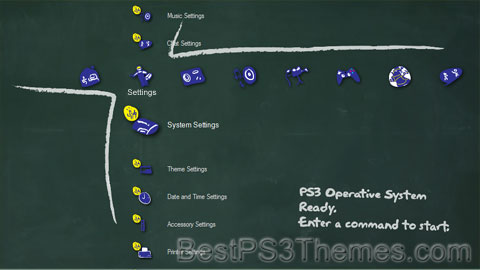
(1 background)
P3T Unpacker v0.12
Copyright (c) 2007. Anoop Menon
This program unpacks Playstation 3 Theme files (.p3t) so that you can touch-up an existing theme to your likings or use a certain wallpaper from it (as many themes have multiple). But remember, if you use content from another theme and release it, be sure to give credit!
Download for Windows: p3textractor.zip
Instructions:
Download p3textractor.zip from above. Extract the files to a folder with a program such as WinZip or WinRAR. Now there are multiple ways to extract the theme.
The first way is to simply open the p3t file with p3textractor.exe. If you don’t know how to do this, right click the p3t file and select Open With. Alternatively, open the p3t file and it will ask you to select a program to open with. Click Browse and find p3textractor.exe from where you previously extracted it to. It will open CMD and extract the theme to extracted.[filename]. After that, all you need to do for any future p3t files is open them and it will extract.
The second way is very simple. Just drag the p3t file to p3textractor.exe. It will open CMD and extract the theme to extracted.[filename].
For the third way, first put the p3t file you want to extract into the same folder as p3textractor.exe. Open CMD and browse to the folder with p3extractor.exe. Enter the following:
p3textractor filename.p3t [destination path]Replace filename with the name of the p3t file, and replace [destination path] with the name of the folder you want the files to be extracted to. A destination path is not required. By default it will extract to extracted.filename.
The Human Ting theme by Paja
Download: TheHumanTing.p3t
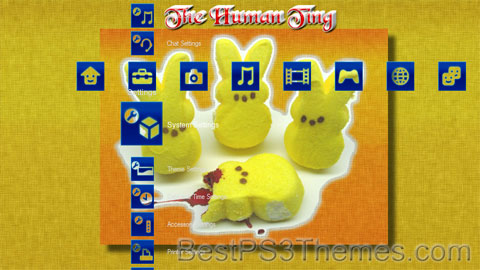
(1 background)
P3T Unpacker v0.12
Copyright (c) 2007. Anoop Menon
This program unpacks Playstation 3 Theme files (.p3t) so that you can touch-up an existing theme to your likings or use a certain wallpaper from it (as many themes have multiple). But remember, if you use content from another theme and release it, be sure to give credit!
Download for Windows: p3textractor.zip
Instructions:
Download p3textractor.zip from above. Extract the files to a folder with a program such as WinZip or WinRAR. Now there are multiple ways to extract the theme.
The first way is to simply open the p3t file with p3textractor.exe. If you don’t know how to do this, right click the p3t file and select Open With. Alternatively, open the p3t file and it will ask you to select a program to open with. Click Browse and find p3textractor.exe from where you previously extracted it to. It will open CMD and extract the theme to extracted.[filename]. After that, all you need to do for any future p3t files is open them and it will extract.
The second way is very simple. Just drag the p3t file to p3textractor.exe. It will open CMD and extract the theme to extracted.[filename].
For the third way, first put the p3t file you want to extract into the same folder as p3textractor.exe. Open CMD and browse to the folder with p3extractor.exe. Enter the following:
p3textractor filename.p3t [destination path]Replace filename with the name of the p3t file, and replace [destination path] with the name of the folder you want the files to be extracted to. A destination path is not required. By default it will extract to extracted.filename.
Burnout Paradise theme by sagitairedudu
Download: BurnoutParadise_6.p3t
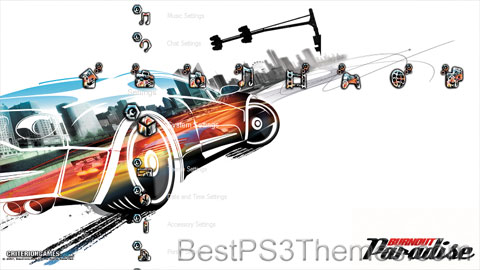
(1 background)
| Burnout Paradise | |
|---|---|
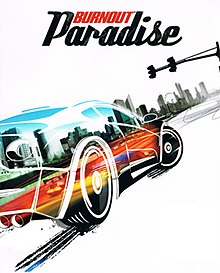 | |
| Developer(s) | Criterion Games[a] |
| Publisher(s) | Electronic Arts |
| Director(s) | Alex Ward |
| Producer(s) | Peter Lake San Shepherd Matt Webster Hamish Young |
| Designer(s) | Craig Sullivan |
| Programmer(s) | Olly Read Paul Ross |
| Artist(s) | Steve Uphill |
| Series | Burnout |
| Engine | RenderWare |
| Platform(s) | Original version PlayStation 3 Xbox 360 Microsoft Windows Remastered PlayStation 4 Xbox One Microsoft Windows Nintendo Switch |
| Release | Original versionThe Ultimate BoxRemastered
|
| Genre(s) | Racing |
| Mode(s) | Single-player, multiplayer |
Burnout Paradise is a 2008 racing video game developed by Criterion Games and published by Electronic Arts for PlayStation 3, Xbox 360 and Microsoft Windows. It was also released on the PlayStation Store and via Xbox Live Marketplace's Games on Demand. It was later added to the libraries of Greatest Hits and Platinum Hits titles and was made backward compatible with the Xbox One in November 2016. It is the first game in the Burnout series to be released on Microsoft Windows.
Paradise's gameplay is set in the fictional "Paradise City", an open world in which players can compete in several types of races. Players can also compete online, which includes additional game modes, such as "Cops and Robbers". Several free game updates introduce new features such as a time-of-day cycle and motorcycles. The game also features paid downloadable content in the form of new cars and the fictional "Big Surf Island".
The game was very well received upon release, with aggregate score sites GameRankings reporting an average score of 88% and Metacritic reporting an average score of 88 out of 100. The game won several awards in 2008, with Spike TV, GameTrailers and GameSpot all awarding it Best Driving Game. Reviewers felt the game had an excellent sense of speed, and praised the open world gameplay, a first for the Burnout series. Burnout Paradise is considered by some to be one of the greatest video games ever made.
A remastered version, titled Burnout Paradise Remastered, which includes all downloadable content (except the Time Savers Pack) and support for higher-resolution displays, was released on 16 March 2018 for PlayStation 4 and Xbox One, and on 21 August for Windows via EA's Origin platform. The online service for the original version of the game was permanently discontinued in August 2019.[4] The remastered version for Nintendo Switch with refreshed online servers was released on 19 June 2020.[5][6]
Burnout Paradise is set in an open-world environment.[7] Players have the opportunity to progress at their own pace and level; the game, unlike others, is not actually set to a rigid gameplay framework.[8] According to Alex Ward, creative director of the game at developer Criterion Games, this game is a "complete reinvention" of the Burnout series. He also said that "to create truly next-generation gameplay, they needed to create a truly next-generation game from the ground up".[9] Initially day and night cycles were not included in the game but a software update entitled "Davis" added this element to the game. For the first time in the series, records are now kept on a player's drivers license, including statistics such as fastest time and biggest crash for every street in the game. Completing events raises the driver rank, which unlocks access to new cars.[10]
In previous Burnout games, "Crash Mode" was a dedicated mode in which players were given multiple scenarios in which to cause the biggest crash. In Burnout Paradise, "Crash Mode", now called "Showtime", can be initiated at any time and place in the game. Showtime does differ from the previous incarnation of Crash Mode being that instead of crashing into a busy intersection and watching a crash play out, Showtime has bouncing the vehicle around for as long as possible to gain points. During a race players may now take any route to get to the destination.[11] Races and other events are started by simply stopping at any of the traffic lights and applying the accelerator and brake at the same time. The game features the ability to customize race settings, such as traffic, race routes, and including/excluding cars based on their boost types.[11][12]
Paradise's damage system has also been reworked. There are now two different types of crashes based on the car's condition after the crash.[13] If the player's car manages to retain all four wheels and does not break its chassis, the player can drive out of the crash and continue playing; this is called a "driveaway". If a player's car loses any wheels, the engine is damaged too much from an impact, the car lands on its side or roof or lands outside of the game's map, the car is in a "wrecked" state and the player will have to wait until their car is reset. Cars dynamically compress and deform around objects they crash into.
Cars now have manufacturer and model names, which are loosely based on real-world cars. Cars may not be "tuned up" or customized apart from color changes, which may be done in real-time by driving through the forecourt of a paint shop, or by selecting the color during vehicle selection.[14] Other real-time changes include driving through the forecourt of a gas station to automatically refill the vehicle's boost meter, and driving through the forecourt of a repair shop to automatically repair the vehicle.[15]
The online lobby system used by most video games has been replaced by a streamlined system known as "Easy Drive". While driving, players simply hit right on the D-pad and the 'Easy Drive' menu appears in the corner of their screen. From there, players are able to invite other players from their friends list. Once friends have joined the game, the host can select the event to play. A "Mugshots" camera feature is available for the PC via webcam, PlayStation 3 via a PS3-compatible webcam, Xbox 360 via Xbox Live Vision,[16] PlayStation 4 via PlayStation Camera, and Xbox One via Kinect. When a player is taken down, their photo, or 'Mugshot', is shown to the aggressor, and vice versa. These photos can then be saved to the PC or console's storage device.[17]
The concept of Burnout Paradise came from director Alex Ward's experience playing open world games, specifically Crackdown, Test Drive Unlimited and Mercenaries: Playground of Destruction. Ward found that with a title like Mercenaries the game's world provided more entertainment than the developers likely planned and gave him a sense of freedom in playing around with inconsequential elements of the game. He wanted to take this idea into Burnout Paradise: "My philosophy was that if me and you both played it for three hours, we'd both do different things".[18] By focusing on discovery and exploration, the game ended up being a racing game without any defined tracks, a novel element at the time, which has since influenced several other racing game developers in their approaches.[18] Ward also wanted to develop the game as a social platform, leading to some of its design choices for multiplayer formats.[18]
Ward, in an interview in 2018, noted the difficulty he had in convincing Electronic Arts to follow his vision. The Burnout series at the time was already seen as a less lucrative property compared to the Need for Speed series by EA, and further, Ward found that EA was not amendable to the open world idea he presented.[18] Ward took steps that he could to make Burnout Paradise a desirable game prior to its release to show his superiors that his ideas were sound, which proved out when the game sold more than one million copies within the first three months of release.[18]

Burnout Paradise has undergone significant changes since its initial release. These have been implemented through several free patches and downloadable packs. In 2008, the first major update, codenamed "Bogart", fixed several glitches and was scheduled to be released on 24 April.[19] It was made available to Xbox 360 users on 18 April and to PlayStation 3 users on the originally scheduled date of 24 April, but this prevented store exclusive cars from being obtainable.
The "Cagney" update was released on schedule on 10 July for PlayStation 3 and on 4 August for the Xbox 360. The update introduced three new Freeburn multiplayer modes: Online Stunt Run, Marked Man and Road Rage. Online Stunt Run involves up to 8 players who simultaneously compete for the highest stunt score within 2 minutes. Road Rage features two teams; one must race to a checkpoint while the other tries to stop them through takedowns. Marked Man is like a game of tag, with one player as the Marked Man who cannot see the other players and has no boost. In addition there are 70 new online challenges. These new challenges are different from Free Burn challenges, being timed. Timed challenges start once all players gather at a point of interest. The players then must all complete an objective within a certain time, such as jumping a ramp. "Cagney" also brought custom soundtracks and 1080i support to the PlayStation 3 version.[20]
An update in which involved motorbikes and night-day cycles appear in the Bikes Pack (originally codenamed the "Davis" update), along with tailored locations, challenges and game modes.[21] The update featured a new dynamic weather system, two starter bikes in the player's junkyard, 70 new bike-only challenges, and special "Midnight Rides" challenges that appear only at night.[22] The Bikes pack was released on 18 September on both the PlayStation 3 and Xbox 360.
On 25 September another update was made available which introduced support for the PlayStation 3 trophies system. Criterion Games originally stated that the trophies could be awarded retroactively to players who had already made certain achievements, but when the update was released they said that this had proved to be impossible and that users would have to start a new game in order to achieve some of the goals.[23] Later on February 5, 2009, Criterion released the free 1.6 update, which included the addition of an in-game browser for the PC and PlayStation 3 versions, which gave users access to the Criterion Games Network. An in-game store was also added to all versions which allowed users to purchase content from within the game. Tweaks were also made to the vehicles (not including the freeburn exclusives) to steer the game more toward beginners and casual players. The stats of all of the cars were lowered, and the beginning cars were changed specifically to make them control better, and harder to crash. Events were also made easier to compensate for the vehicle changes.[24]
Burnout Paradise is the first game in the Burnout series to be released for the PC. Criterion made use of existing graphics technology and introduced enhanced visuals and the ability to play the game across multiple monitors to enhance widescreen playing. Players can link three 4:3 monitors to play in a Polyvision aspect ratio. PC users are also able to download a trial version of the game for free. It includes the entire map and three cars but will expire after thirty minutes. All saved data will be carried over if the user decides to purchase the full game.[25]
A demo was made available on 13 December 2007 for both PlayStation 3 via PlayStation Store and Xbox 360 via Xbox Live Marketplace.[26][27] From January 4 through 14, Criterion raised the maximum number of players for the online Freeburn in the Paradise demo to 8 players (online play for the demo has since been shut down completely). With it, a total of 13 new Freeburn challenges were made available for players to play.[28] In 2008, Paradise was made available for download on the PlayStation Store.[29] Upon installation and first execution, all updates are downloaded and installed, which allows the player to have the latest version of Burnout Paradise.
Burnout Paradise features in-game advertisements for a number of brands, including Burger King, JL Audio, Nvidia, Gillette, Vizio, CompUSA and EVGA. From 6 October 2008, in-game billboards featured ads for the then United States Democratic Presidential Candidate Barack Obama. Electronic Arts confirmed that the Obama campaign paid for the advertisements, marking the first time that a United States presidential candidate has bought in-game advertising.[30] The Obama campaign ran only on the Xbox 360 version of the game.[30]
The Xbox 360 version of Burnout Paradise was made available for backward compatibility with the Xbox One in November 2016.[31] On 16 December, it was made available to Xbox Live Gold members for free until 31 December.[32]
Criterion has disabled the optional online features for the original releases in August 2019.[33]
A remastered version of Burnout Paradise was released for PlayStation 4 and Xbox One consoles on 16 March 2018; a version for Windows was released for Origin Access subscribers on 16 August and was fully released on 21 August via Origin platform.[34]
The remaster contains all the previously released downloadable content, except for the Time Savers Pack (a DLC pack that unlocks all vehicles in the game without the need to progress through single-player), and support for higher-resolution monitors (up to 4K resolutions) with 60 frames per second support.[3] A version for Nintendo Switch was released on 19 June 2020.[5][35] Unlike the original, the Remastered version does not have real life in-game advertisements and are instead replaced by fictional ones.
In addition to the free updates, Criterion has released several optional, premium packs that add content like new cars, areas and modes. The first update was the "Burnout Party Pack" and launched on 5 February 2009 in North America and the United Kingdom.[36] It focuses on hotseat multiplayer gameplay, which offers a Freeburn Challenge-like setting but for players on the same console, who pass a single controller between players to complete challenges. The challenges are split into 'Speed', 'Stunt' and 'Skill' with up to 8 rounds and up to 8 players can play at once. Criterion also announced the combo pack Burnout Paradise: The Ultimate Box that launched around the same time which contains the original game, plus the Cagney, Bikes, Party pack and Update pack all in the same package which contained "a mountain of new refinements".[37]
The first premium content pack called "Legendary Cars" featured four cars inspired by famous vehicles from film and television:[38] the Jansen P12 88 Special (based on the DeLorean time machine from the Back to the Future films), the Hunter Manhattan Spirit (based on the Ecto-1 from the Ghostbusters films), the Carson GT Nighthawk (based on KITT from the television series, Knight Rider), and the Hunter Cavalry Bootlegger (based on The General Lee from the TV series The Dukes of Hazzard).[39] The Legendary Cars pack was released on 19 February 2009 for the PlayStation 3 and the Xbox 360, and later in 2009 for the PC.[40]
The second one is "Toy Cars" pack. It features a collection of new vehicles designed with a "toy car" aesthetic, although modelled as full-size cars. The Toy Cars pack has been released in three packs. The full pack offers all toy cars along with the Nakamura Firehawk, a toy motorcycle, while the others split the content into two parts, minus the Firehawk.[41]
On 12 March 2009, the "Boost Specials" pack was released. It featured two cars: the Carson Extreme Hotrod and the Montgomery Hawker Mech. The Carson was described as the fastest car in the game and featured a 'locked' boost; the car continues to boost until it is brought to a stop in any manner. The vehicle dynamics system were rewired so that the Carson performs more realistically than any other car in the game. The Montgomery Hawker Mech also featured a unique boost system, which allows the player to willingly switch between the three different boost types at the touch of a button.[42]
In 2009, Criterion released "Cops & Robbers" on 30 April for PlayStation 3 and Xbox 360.[43] The content does not involve AI Police patrol cars but instead borrows from the Pursuit modes of older Burnout games, notably Burnout 2: Point of Impact. Players are split into teams, the Cops and the Robbers. Teams attempt to return gold bars to their respective bases to score points.[44] Every Paradise car (except Carbon and Premium DLC cars) receives a Police livery with the content.[45]
Originally announced as the "Eastwood pack coming in Fall 2008",[46] the expansion known as "Big Surf Island" was released on 11 June 2009.[47] Design for the island was guided by the principle of "if you can see it, you can drive it".[48][49] The island puts emphasis on the playground aspect of Burnout. The developers mentioned that in their telemetry they noticed that players congregate in areas of Paradise City that lend themselves to stunt-driving, and so the idea was to create an entire island to accommodate player desire. Big Surf Island also features new vehicles, which includes the Carson Dust Storm buggy, a car tailor-made for stunts. In addition to the Dust Storm buggy two specially featured cars, the Hunter Olympus "Governor" and the Carson Annihilator Street Rod are also included. The unlockable cars also include toy versions of all four "Legendary Cars" pack vehicles and a special Jansen P12 Diamond awarded once all 500 freeburn challenges were completed.[50] It features several new events, billboards, smash gates, and mega jumps. New Trophies and Achievements were also added along with a new 'Big Surf Island License' to obtain.[51]
| Aggregator | Score |
|---|---|
| Metacritic | (X360) 88/100[52] (PS3) 87/100[53] (PC) 87/100[54] (PS4) 82/100[55] (XONE) 79/100[56] (NS) 78/100[57] |
| Publication | Score |
|---|---|
| 1Up.com | A[58] |
| Eurogamer | 8/10[59] |
| GameTrailers | 8.8/10[60] |
| IGN | 8.8/10[61] |
| Official Xbox Magazine (US) | 9/10[62] |
| Play | 74%[63] |
| Publication | Award |
|---|---|
| Spike | Best Racing/Driving Game[64] |
| GameSpot | Best Downloadable Content[65] Best Driving Game[66] |
| GameTrailers | Best Racing Game[67] |
| Academy of Interactive Arts & Sciences | Racing Game of the Year[68] |
Upon release, Burnout Paradise was met with very positive reviews, according to review aggregator Metacritic.[54][53][55][52][56]
Reviewers praised the game's open world, stating "Burnout Paradise is an amazing open-world racing game that stays true to the Burnout legacy", but that the large world may "feel a little daunting at first".[69] New gameplay mechanics such as gas stations and body repair shops were also praised which "mitigate potential frustration when the heat is on".[59] Hyper's Daniel Wilks commends the game for its "great sense of speed and things that go boom".[70] IGN's Chris Roper praised the vehicle unlock system, which gives the player a new vehicle with each license, and also gives the player the opportunity to "take down" certain vehicles, which earns the player a reward if completed.[61] He further lauded the game as "controlled chaos".[61] The Guardian's Keith Stuart added that the game "feels incredibly good to drive".[71]
However, some reviewers were disappointed that there was no option to restart a race or event.[61] Instead the player had to either fail the event, or cancel the race by bringing the vehicle to a stop for a few seconds, and then return to the specific place on the map to try that particular race or event again. Criterion responded to this criticism by stating that they don't feel that this is a problem and that adding a "retry" option would introduce loading screens, which they "hate with a passion".[72] Despite this, the option to restart an event was later added to the game via a free software update.[24] Eurogamer found DJ Atomika, the game's guide, to be "instantly dislikeable".[59]
The Remastered release was met with similarly positive reviews, albeit slightly less than the original release. Metacritic gave the PlayStation 4 version a score of 82 out of 100, and the Xbox One version a score of 79 out of 100.
Paradise won several awards in 2008, with Spike TV, GameTrailers and GameSpot all awarding it Best Driving Game.[64][66][67] Additionally, Paradise won GameSpot's award for Best Downloadable Content in 2008.[65] During the 12th Annual Interactive Achievement Awards, the Academy of Interactive Arts & Sciences awarded Burnout Paradise with "Racing Game of the Year".[73]
The game has been the subject of several academic papers investigating a range of fields, often connected to the title's intensity and need for fast reaction time. These include studies on gamer cardiology,[74] phenomenological correspondence and control abstraction[75] and computer game pedagogy.[76]
Bone Thugs-N-Harmony theme by Grasuc
Download: BoneThugs-N-Harmony.p3t
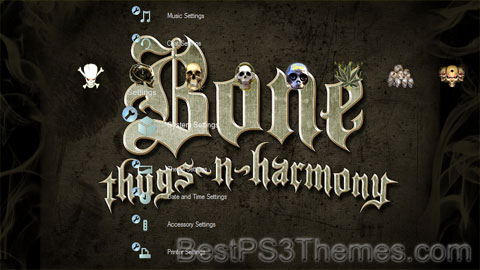
(4 backgrounds)
Redirect to:
Spongebob Squarepants theme by Gorizilla
Download: SpongebobSquarepants.p3t
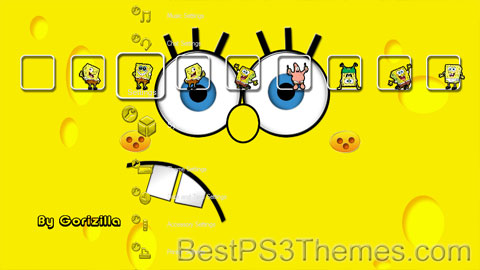
(1 background)
Redirect to:
This page is a redirect. The following categories are used to track and monitor this redirect:
|
Grand Theft Auto: IV (V1.5) theme by vanillacoke
Download: GTAIV_V1.5.p3t
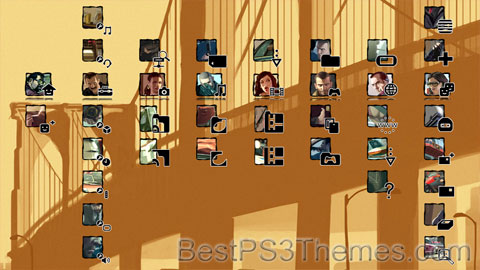
(1 background)
P3T Unpacker v0.12
Copyright (c) 2007. Anoop Menon
This program unpacks Playstation 3 Theme files (.p3t) so that you can touch-up an existing theme to your likings or use a certain wallpaper from it (as many themes have multiple). But remember, if you use content from another theme and release it, be sure to give credit!
Download for Windows: p3textractor.zip
Instructions:
Download p3textractor.zip from above. Extract the files to a folder with a program such as WinZip or WinRAR. Now there are multiple ways to extract the theme.
The first way is to simply open the p3t file with p3textractor.exe. If you don’t know how to do this, right click the p3t file and select Open With. Alternatively, open the p3t file and it will ask you to select a program to open with. Click Browse and find p3textractor.exe from where you previously extracted it to. It will open CMD and extract the theme to extracted.[filename]. After that, all you need to do for any future p3t files is open them and it will extract.
The second way is very simple. Just drag the p3t file to p3textractor.exe. It will open CMD and extract the theme to extracted.[filename].
For the third way, first put the p3t file you want to extract into the same folder as p3textractor.exe. Open CMD and browse to the folder with p3extractor.exe. Enter the following:
p3textractor filename.p3t [destination path]Replace filename with the name of the p3t file, and replace [destination path] with the name of the folder you want the files to be extracted to. A destination path is not required. By default it will extract to extracted.filename.
Hello Kitty theme by Tony (gaara1978)
Download: HelloKitty.p3t
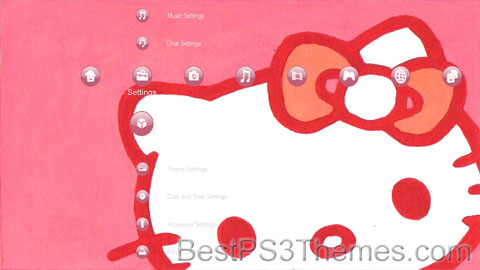
(8 backgrounds)
You can help expand this article with text translated from the corresponding article in Japanese. (November 2023) Click [show] for important translation instructions.
|
| Hello Kitty | |
|---|---|
| Sanrio character | |
 | |
| First appearance | March 1975 (created 1974) |
| Created by | Yuko Shimizu |
| Voiced by | Megumi Hayashibara (1990–2023), others[a] |
| In-universe information | |
| Full name | Kitty White[5] |
| Species | Anthropomorphic cat |
| Gender | Female |
| Family | Mimmy (twin sister) George (father) Mary (mother) Anthony (grandfather) Margaret (grandmother) Charmmy Kitty (pet cat) |
| Significant other | Dear Daniel (boyfriend) |
| Nationality | British |
Hello Kitty (Japanese: ハロー・キティ, Hepburn: Harō Kiti),[6] also known by her real name Kitty White (キティ・ホワイト, Kiti Howaito),[5] is a fictional character created by Yuko Shimizu, currently designed by Yuko Yamaguchi, and owned by the Japanese company Sanrio.[7][8][9] Sanrio depicts Hello Kitty as a British anthropomorphized white cat with a red bow and no visible mouth.[10][11] According to her backstory, she lives in a London suburb with her family, and is close to her twin sister Mimmy, who is depicted with a yellow bow.[5][12]
Hello Kitty was created in 1974 and the first item, a vinyl coin purse, was introduced in 1975.[13][14] Originally, Hello Kitty was only marketed towards pre-teenage girls, but beginning in the 1990s, the brand found commercial success among teenage and adult consumers as well.[15] Hello Kitty's popularity also grew with the emergence of kawaii (cute) culture.[16] The brand went into decline in Japan after the 1990s, but continued to grow in the international market.[17] By 2010 the character was worth $5 billion a year and The New York Times called her a "global marketing phenomenon."[17] She did about $8 billion at retail in 2013.[18]
UNICEF has appointed Hello Kitty children's ambassador and the Japanese government appointed her ambassador of tourism.[15] There are Sanrio theme parks based on Hello Kitty: Harmonyland in Hiji, Ōita, Japan,[19] Sanrio Puroland in Tama New Town, Tokyo, Japan, and Hello Kitty Shanghai Times in Shanghai, China.[20] The Hello Kitty media franchise has grown to include a number of animated series targeted towards children, as well as several comics, animated films, video games, books, music albums and other media productions. A variety of products have featured the character over the years, like school supplies, clothing, accessories, and toys, along with other items. In 2008, there were over 50,000 different Hello Kitty branded products.[15]
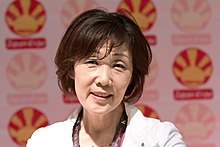
In 1962, Shintaro Tsuji, founder of Sanrio, began selling rubber sandals with flowers painted on them.[21] Tsuji noted the profits gained by adding a cute design to the shoes and hired cartoonists to design cute characters for his merchandise.[21] Hello Kitty was designed by Yuko Shimizu and was added to the lineup of early Sanrio characters in 1974.[8]
Hello Kitty was initially known only as "the white kitten with no name" (名前のない白い子猫).[11] Shimizu got the name Kitty from Lewis Carroll's Through the Looking-Glass; during a scene early in the book, Alice plays with a cat she calls Kitty.[22] Sanrio's motto is "social communication," and Tsuji wanted the brand name to reflect that by including a greeting. He first considered "Hi Kitty" before finally settling on "Hello Kitty," her current name.[23] Sanrio decided to make Hello Kitty British because foreign countries, in particular Britain, were trendy in Japan at the time of Hello Kitty's creation. Sanrio already had several characters set in the US, and it wanted Hello Kitty to be different.[9][15]
In 1976 Setsuko Yonekubo temporarily took over as lead designer for Hello Kitty, after Shimizu left Sanrio. In 1980 Yuko Yamaguchi became lead designer and has remained in charge since.[24] Yamaguchi has said that fashion, movies, and TV inspire her in creating new designs. New series involving Hello Kitty with different themed designs are released regularly, following current trends.[9][17]
Spokespeople for Sanrio have said that Hello Kitty has no mouth, as they want people to "project their feelings onto the character" and "be happy or sad together with Hello Kitty."[9][25] Another explanation Sanrio has given for Hello Kitty's lack of a mouth is that she "speaks from the heart. She's Sanrio's ambassador to the world and isn't bound to any particular language."[15] However, Yuko Yamaguchi has also said that "Kitty has a mouth" that is "hidden in the fur".[26] Representatives for Sanrio have said that they see Hello Kitty as a symbol of friendship, which they hope she will foster between people across the world.[9] There has been speculation that Hello Kitty has her origins in Maneki Neko, a traditional Japanese cat figurine. The name "Hello Kitty" is a back-translation of Maneki Neko, meaning "beckoning cat" in English. Despite this, no definitive statement supports that speculation.[27] Hello Kitty has also instead been put forth as an early example of mukokuseki, a Japanese term meaning "stateless" or "nationless" in reference to characters lacking any identifiable national background.[28]

The character's first appearance on an item was in March 1975 on a vinyl coin purse sold in Japan, where she was pictured sitting between a bottle of milk and a goldfish bowl.[13][14][29] She first appeared in the United States in 1976 when Sanrio opened a Gift Gate store in San Jose, California.[30][31]
Hello Kitty sold well immediately after her 1975 launch, and Sanrio's sales increased sevenfold.[17] Due to Japan's growing economy, many Japanese children could afford to buy Hello Kitty products.[32] Her popularity also grew with the emergence of kawaii culture, which embraces cuteness.[16]
UNICEF named Hello Kitty as children's ambassador to the United States in 1983, children's ambassador in Japan in 1994, and gave her the title of UNICEF Special Friend of Children in 2004, a title unique to her.[33][34][35]
Originally, Hello Kitty was only marketed towards a child and preteen audience. In the 1990s, the target market for Hello Kitty was broadened to include teenagers and adults as a retro brand.[9][15] Marketing to those who could not get Hello Kitty merchandise as children, and those who fondly remember items they had, Sanrio began selling Hello Kitty branded products such as purses and laptops.[9][15][17] The 1994–1996 Face series was the first to be designed specifically for mature consumers.[9]
The Hello Kitty brand rose to greater prominence internationally during the late 1990s. At that time, several celebrities, such as Mariah Carey, had adopted Hello Kitty as a fashion statement.[15] New products featuring the character were made available in a large variety of American department stores.
Hello Kitty's popularity in Japan peaked in the late 1990s when she was the country's top-grossing character. In 2002, Hello Kitty lost her place as the top-grossing character in Japan in the Character Databank popularity chart. In a 2010 survey, she was in third place behind Anpanman and Pikachu from Pokémon.[17] In 2010, The New York Times attributed the character's relative decline in Japan to her biography not being "compelling enough to draw many fans." The newspaper later wrote that analysts called the characterization "weak,"[17] and that Hello Kitty not having a mouth has dampened her success as an animated TV character.[17] According to Character Databank, Hello Kitty was the third highest-grossing character in Japan as of 2013.[36] In 2019 and 2020, Character Databank ranked her fifth, and as of 2021 she was out of the top five.[37][38][39]
Overseas, her global popularity has increased over the years.[17] According to Sanrio, Hello Kitty was appearing on 12,000 new products each year as of 1999.[23] Beginning in 2007, following trends in Japan, Sanrio began using darker designs for Hello Kitty with more black and less pink and pulled away from kawaii styles.[17] By 2008, Hello Kitty was responsible for half of Sanrio's $1 billion net income, and there were over 50,000 different Hello Kitty branded products in more than 60 countries.[15] By 2010 the character was worth $5 billion a year and The New York Times called her a "global marketing phenomenon".[17] Worldwide annual sales reached $8 billion in 2013.[18]
In July 2008, the Dutch artist Dick Bruna, creator of Miffy, alleged that Hello Kitty is a copy of Miffy, being rendered in a similar style. He stated disapprovingly in an interview for the British newspaper The Daily Telegraph: "That" [...] "is a copy [of Miffy], I think. I don't like that at all. I always think, 'No, don't do that. Try to make something that you think of yourself'."[40] Mercis, the firm that managed copyrights for Bruna, took Sanrio to court over their Hello Kitty-associated character Cathy, a rabbit which made her first appearance in 1976 and which Mercis argued infringed the copyright for Miffy. A court in Amsterdam ruled in favour of Mercis in November 2010 and ordered Sanrio to stop the production and sale of merchandise featuring Cathy in the Benelux countries. However, in June 2011, the two companies announced that they had reached a settlement agreement to end their legal dispute. Sanrio stopped using the Cathy character, and the two firms jointly donated €150,000 for reconstruction after the 2011 Tōhoku earthquake and tsunami.[41]
As of 2014, 90% of the profits from Hello Kitty came from licensing of products for the international market.[42] She has been particularly popular in other Asian countries for decades, such as in China, where her cultural impact is comparable to that of Barbie in the Western world.[43] In 2008, Japan named Hello Kitty the ambassador of Japanese tourism in both China and Hong Kong, marking the first time Japan's tourism ministry had appointed a fictional character to the role.[44] Sharon Kinsella, a lecturer at Oxford University on Japanese sociology, called the selection of Hello Kitty "a bit farcical ... as if a dumbed-down cultural icon ... can somehow do something significant to alter the gnarly and difficult state of China–Japan relations."[15]
In the United States, Hello Kitty is recognized by more than 80% of young adults in the 18–23 age group, as of 2016[update].[45] In 2014 a four-day convention, Hello Kitty Con in Los Angeles, attracted over 25,000 visitors. The convention was held in celebration of Hello Kitty's 40th anniversary.[46] Sanrio's Puroland Tokyo theme park also held a celebration spanning several days in November 2014.[47]
Hello Kitty is a gijinka, an anthropomorphism or personification of a Japanese Bobtail cat.[48][11][49] Official character profiles list her full name as Kitty White (キティ・ホワイト, Kiti Howaito), born in the suburbs of London, England, on November 1. Her height is described as five apples and her weight as three apples. She is portrayed as a bright and kind-hearted girl, very close to her twin sister Mimmy. She is good at baking cookies and loves her mama's homemade apple pie. She likes to play the piano and collect cute things, and her favorite subjects in school are English, music, and art.[5][50][12]
Hello Kitty is portrayed with a large family with the surname White. Her twin sister Mimmy is described as "shy and very girly," interested in sewing and dreaming of marriage. While Hello Kitty wears a red bow on her left ear, Mimmy wears a yellow one on her right. Their papa George is described as dependable, humorous but also absent-minded. Their mama Mary is portrayed as a good cook who loves doing housework. Grandpa Anthony likes to tell stories and grandma Margaret likes sewing.[50][12] In addition to family, Hello Kitty is also depicted with several animal friends, including the mice Joey and Judy, the bears Tippy and Thomas, the raccoon Tracy and the squirrel Rorry.[51]
Aside from the core Hello Kitty characters, several spinoff characters have been created: Hello Kitty's boyfriend Dear Daniel in 1999, Charmmy Kitty, Hello Kitty's pet cat, and Sugar, her pet hamster, both in 2004, and her superhero alter-ego Ichigoman in 2011.[29][52]
SFGATE said in 2004 that in light of the level of success of Hello Kitty, her fictional biography "seems almost too modest – or irrelevant" and "doesn't seem to have played much of a part" in the success.[16]
In 2014 an anthropologist was told by Sanrio that Kitty White was not simply a cat (i.e. "depicted on all fours"), describing her as a little English girl called Kitty White, from outside London.[10] Following reports that interpreted this to mean she was human, a Sanrio PR representative said that the organization had "never said she was a human", explaining anthropomorphization by comparing the character to Mickey Mouse: "No one would mistake the Disney character for a human–but at the same time he's not quite a mouse. Just like Hello Kitty isn't a human, she's not quite a cat either."[48] Sanrio stated further, "Hello Kitty was done in the motif of a cat. It's going too far to say that Hello Kitty is not a cat."[11]
There have been several different animated series starring Hello Kitty. The first was Hello Kitty's Furry Tale Theater, an animated television series with 13 22-minute episodes that premiered in 1987.[53] The next, an OVA titled Hello Kitty and Friends, spanned 30 entries originally released in Japan between 1989 and 1994. Hello Kitty's Paradise came out in 1999 and was 16 episodes long. Hello Kitty's Stump Village came out in 2005, and The Adventures of Hello Kitty & Friends came out in 2008 and has aired 52 episodes. A crossover series under the name Kiss Hello Kitty (that paired animated versions of the members of the rock band KISS with Hello Kitty) was announced in March 2013. Produced by Gene Simmons, this show was supposed to air on The Hub Network (now Discovery Family),[54] but it never came to fruition.
Hello Kitty's Paradise was a long-running live-action children's program that aired on TXN from January 1999 to March 2011. It was the longest-running weekly kids' television program in the network's history. In January 2011, the show's creators mutually agreed to end the series after twelve seasons, with the final episode being broadcast on 29 March 2011.
In August 2018, Sanrio began streaming a CGI animated series on YouTube. It features Hello Kitty talking to the camera about her life in the style of vlogging YouTubers.[55][56]
Sanrio began streaming the newest 2D animated Hello Kitty series Hello Kitty and Friends Supercute Adventures on YouTube on 26 October 2020.[57]
Hello Kitty had two Japanese comic series serialized in Ribon, a shōjo manga magazine - Hello Kitty Doki (ran from May 2007 to April 2008)[58] and Hello Kitty Peace (released in June 2008).[59]
In March 2016, Sanrio launched a webcomic featuring Hello Kitty as a strawberry-themed superhero called Ichigoman (ichigo meaning strawberry). The webcomic is created by Toshiki Inoue and Shakua Sinkai and updates once a month.[60] Ichigoman first appeared in 2011 in an exhibition with Yuko Yamaguchi's art.[52]
Hello Kitty has her own branded album, Hello World, featuring Hello Kitty-inspired songs performed by a collection of artists including Keke Palmer, Cori Yarckin, and Ainjel Emme under Hello Kitty's Lakeshore Records record label.[61] Hello Kitty was also chosen by AH Software to be the basis of the new Vocaloid Nekomura Iroha (猫村いろは, Nekomura Iroha)[62] to celebrate the 50th anniversary of Sanrio.[63]
Musician Yoshiki unveiled the Hello Kitty theme song "Hello Hello" in November 2014 at the first Hello Kitty Con. Yoshiki, who was the first celebrity to have his own Hello Kitty doll, "Yoshikitty," was approached by Yamaguchi to compose the song seven years prior.[64]
There are numerous Hello Kitty games starting with the release of the first title for Famicom in 1992; however, the majority of these games were never released outside of Japan. Hello Kitty also has made cameo appearances in games featuring other Sanrio characters, such as the Keroppi game, Kero Kero Keroppi no Bōken Nikki: Nemureru Mori no Keroleen. Special-edition consoles such as the Hello Kitty Dreamcast, Hello Kitty Game Boy Pocket, and Hello Kitty Crystal Xbox have also been released exclusively in Japan.
Hello Kitty appeared as a guest character in Sega's Sonic Dash in 2016, as part of Sega's partnership with Sanrio. Hello Kitty and My Melody (another Sanrio character) appeared together in Super Mario Maker as unlockable Mystery Mushroom costumes. Hello Kitty appears as a playable character via downloadable content in Super Monkey Ball Banana Mania.[65]